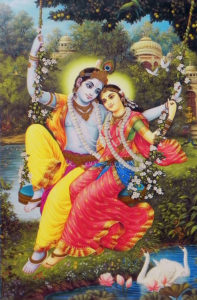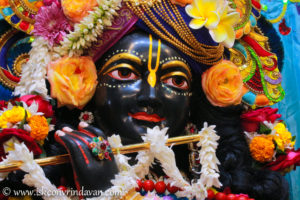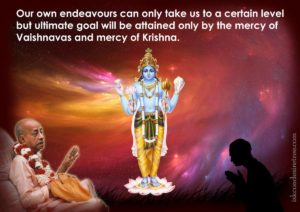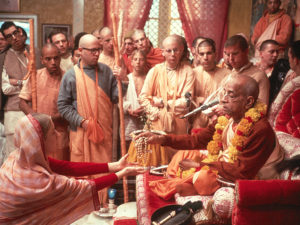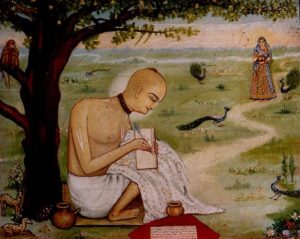Vrindavana
vraja-bhūmi cintāmaṇi, cidānanda-ratna-khani
(The land of Vraja is a wish-fulfilling gem; indeed, it’s a jewel mine of consciousness and bliss)
Let me glorify Vrajabhumi, the place where Sri Krsna enjoys transcendental pastimes. Simply by drinking with their ears the nectarean description of Vrajabhumi, the liberated souls abandon the bliss of impersonal Brahman and yearn to attain the land of Vraja.
With a pure heart let me worship Vrajabhumi, which is the form of the sweetness of meditation on Sri Krsna, which is eternal, transcendental, blissful, and peerless, and which, although it cannot be understood by ordinary people, is easily understood by its residents.
Millions of material universes and even millions of spiritual Vaikuntha planets are not very significant in comparison to Vrindavana, where Sri Krsna enjoyed lunch with His friends on the Yamuna’s sandy bank, and enjoyed many other transcendental pastimes.
Sri Krsna’s friends and associates, who enjoy pastimes with Him as equals, reside in this perfectly spiritual abode of Vrindavana.
All these associates of the Lord have spiritual bodies, although their forms and activities appear ordinary and material to the conditioned souls. These associates of the Lord are enchanted by Lord Krsna’s charming pastimes in Vraja.
Vrindavana cannot be understood by conditioned souls, for although it may appear to be material, all its villages, forests, and cow-pastures are perfectly spiritual.
Some portion of transcendental Vrindavana becomes visible in this world at the time of Lord Krsna’s manifest pastimes. Conditioned souls think Vrindavana is material, although actually it is spiritual, and beyond their ability to understand or describe.
Wild rams have chewed fragrant kakkola berries and wild buffaloes with their horns have torn the bark and branches of fragrant sarala trees. All this has made the Vraja forest very aromatic.
Wild elephants have broken the tender young branches of fragrant sallaki trees, and wild buffaloes have spread the aroma of fresh grass by their grazing. All this has made the Vraja forest very aromatic.
Filled with many rasala trees, panasa trees, amrataka, sriphala, jambhu, palasa, pungasana, coconut, madhuka, punnaga, sirisa, priya, bilva, arjuna, karma ranga, kapittha, lodhra, priya, lavali, asoka, lakuca, karira, campaka, tamala, nava-malika, jatidvaya, rayabilva, kosataki, parkatika, vata, asvattha, sala, khadira, and sami trees, which all have many wonderful splendid fruits and flowers, and also filled with many lavanga vines, and various other beautiful vines, and also filled with many parrots and other birds, as well as many wild beasts, the forests of Vraja are splendidly beautiful.
In Vraja there are many splendid ponds, pools, lakes, and rivers, all filled with many white, blue, red, yellow, and multicoloured kahlara, padma, and utpala lotus flowers, as well as many swans and other water-birds.
In some places the ground of Vraja is made of camphor dust. In some places it is saffron. In some places it is made of ground musk, and in some places it is made of the aromatic substances used in religious ceremonies.
From the branches and roots of the trees of Vraja all Brahmas and Sivas emanate. Although the trees of Vraja are as splendid as the sun, they still are wonderful parasols to shade one from the sun’s rays. They shine with the lustre of youth, just as the four Kumaras.
The trees of Vraja were never planted or husbanded. They never grew from any seed. They glisten with many leaves and flowers. They bear many ripe, unripe, and ripening fruits.
The splendid trees of Vrajabhumi are perfectly spiritual in nature and full of all potencies. They are just like the incarnations of the Supreme Personality of Godhead. Just as the conditioned souls misunderstand the spiritual nature of the Supreme Lord’s incarnations, in the same way they misunderstand the glory of these trees in Vraja.
Splendid with many eternal flowers, fruits and eternally sprouting fresh new buds, the vines fulfil all the desires of the infallible Supreme Personality of Godhead and His devotees.
Sri Krsna, the moon of Vraja, enjoys pastimes and also rests in these groves, which are filled with many wonderful trees and vines eternally blossoming with many beautiful flowers, even down to their roots.
In the groves of Vraja, the cuckoos and bumblebees sing very melodiously, the plants are all splendidly beautiful, the camari does gracefully move their tails, and the musk oxen diffuse a sweet aroma in all directions.
Among Vrindavana’s splendid forests, which make the splendours of Vaikuntha seem very pale, the very beautiful forest named Vrindavana-vana is the best.
They who offer respectful obeisances to her or bathe in her waters, the Yamuna, which is like a moat of black mascara encircling Vrindavana, transform into pure devotees carrying Lord Krsna in their hearts.
The Yamuna river is like a blue lotus flower garland, a sapphire necklace, or a blue sash worn by the goddess of Vrindavana.
Passing the seven seas and seven planetary systems, and breaking through the sevenfold covering of the universe, the Yamuna enters the spiritual Goloka planet and wanders here and there to serve Vrindavana by carrying water.

Many greedy men will wait at a rich man’s doorstep, hoping to meet him and benefit hundreds of thousands of times over. In the same way the Yamuna flows in a very winding course, greedy to get some of the wealth of Vrindavana forest.
Everywhere in Vrindavana and on the Yamuna’s shores, are trees that are like the Lord’s incarnations, that give the gift of pure love, and that make one remember the Lord, making He who is the moon of Vraja suddenly rise within the heart.
Generally the six seasons come one after another, and the qualities of only one season are manifest at any given time. Here in Vrindavana, He who is the moon of Vrindavana can enjoy the pastimes of any season at any time.

In Vrindavana all the seasons are eternal, and they all diligently serve Sri Krsna, the moon of Vrindavana. The gopis decorate Sri Krsna with garlands and other ornaments made from the flowers of many different seasons.
The animals, birds, trees, vines and all other living entities that reside in Vrindavana yearn to see the rising of Vrindavana’s moon (Krsna).
Originally there is only one kalpa vrksa tree in Vrindavana, and the other trees have attained the qualities of kalpa vrksa trees by its association. In the same way, there is only one Sri Krsna, the master of Vrindavana, and by enjoying pastimes with Him His friends have attained qualities like His.
(Selected verses from Sri Vraja-riti-cintamani by Srila Visvanatha Cakravarti Thakura)
New Year prayer for all the devotees
May the cowherd boy who is a festival of ecstatic bliss for the hearts of the fortunate creatures residing in the groves of Govardhana, who eagerly enjoys loving pastimes in the forests of Vrindavana with the gopīs, and whose complexion is as splendid as a great sapphire, eternally enjoy transcendental pastimes in our hearts.
(Padyāvalī 75)
All glories to Sri Vrindavana Dhama
All glories to Sri Guru and Gauranga.
All glories to Srila Prabhupada.
(All pictures from HH Indradyumna maharaj’s Vrindavana yatras)

